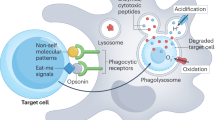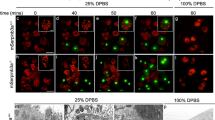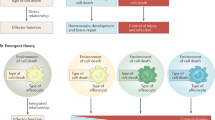Abstract
In the nematode Caenorhabditis elegans programmed cell death requires the killer genes egl-1, ced-4 and ced-3 (refs 1 and 2), and the engulfment of dying cells requires the genes ced-1, ced-2, ced-5, ced-6, ced-7, ced-10 and ced-12 (refs 3,4,5). Here we show that engulfment promotes programmed cell death. Mutations that cause partial loss of function of killer genes allow the survival of some cells that are programmed to die, and mutations in engulfment genes enhance the frequency of this cell survival. Furthermore, mutations in engulfment genes alone allow the survival and differentiation of some cells that would normally die. Engulfment genes probably act in engulfing cells to promote death, as the expression in engulfing cells of ced-1, which encodes a receptor that recognizes cell corpses6, rescues the cell-killing defects of ced-1 mutants. We propose that engulfing cells act to ensure that cells triggered to undergo programmed cell death by the CED-3 caspase7 die rather than recover after the initial stages of death.
This is a preview of subscription content, access via your institution
Access options
Subscribe to this journal
Receive 51 print issues and online access
$199.00 per year
only $3.90 per issue
Buy this article
- Purchase on Springer Link
- Instant access to full article PDF
Prices may be subject to local taxes which are calculated during checkout


Similar content being viewed by others
References
Ellis, H. M. & Horvitz, H. R. Genetic control of programmed cell death in the nematode C. elegans. Cell 44, 817–829 (1986).
Conradt, B. & Horvitz, H. R. The C. elegans protein EGL-1 is required for programmed cell death and interacts with the Bcl-2-like protein CED-9. Cell 93, 519–529 (1998).
Hedgecock, E. M., Sulston, J. E. & Thomson, J. N. Mutations affecting programmed cell deaths in the nematode Caenorhabditis elegans. Science 220, 1277–1279 (1983).
Ellis, R. E., Jacobson, D. M. & Horvitz, H. R. Genes required for the engulfment of cell corpses during programmed cell death in Caenorhabditis elegans. Genetics 129, 79–94 (1991).
Chung, S., Gumienny, T. L., Hengartner, M. O. & Driscoll, M. A common set of engulfment genes mediates removal of both apoptotic and necrotic cell corpses in C. elegans. Nature Cell Biol. 2, 931–937 (2000).
Zhou, Z., Hartwieg, E. & Horvitz, H. R. CED-1 is a transmembrane receptor that mediates cell corpse engulfment in C. elegans. Cell 104, 43–56 (2001).
Yuan, J., Shaham, S., Ledoux, S., Ellis, H. M. & Horvitz, H. R. The C. elegans cell death gene ced-3 encodes a protein similar to mammalian interleukin-1 beta-converting enzyme. Cell 75, 641–652 (1993).
Vaux, D. L. & Korsmeyer, S. J. Cell death in development. Cell 96, 245–254 (1999).
Sulston, J. E. & Horvitz, H. R. Post-embryonic cell lineages of the nematode, Caenorhabditis elegans. Dev. Biol. 56, 110–156 (1977).
Robertson, A. M. G. & Thomson, J. N. Morphology of programmed cell death in the ventral nerve cord of C. elegans larvae. J. Embryol. Exp. Morphol. 67, 89–100 (1982).
Metzstein, M. M., Stanfield, G. M. & Horvitz, H. R. Genetics of programmed cell death in C. elegans: Past, present and future. Trends Genet. 14, 410–416 (1998).
Albert, M. L., Kim, J. I. & Birge, R. B. alpha Vβ5 integrin recruits the CrkII-Dock180-rac1 complex for phagocytosis of apoptotic cells. Nature Cell Biol. 2, 899–905 (2000).
Wu, Y. C. & Horvitz, H. R. The C. elegans cell corpse engulfment gene ced-7 encodes a protein similar to ABC transporters. Cell 93, 951–960 (1998).
Liu, Q. A. & Hengartner, M. O. Candidate adaptor protein CED-6 promotes the engulfment of apoptotic cells in C. elegans. Cell 93, 961–972 (1998).
Wu, Y. C. & Horvitz, H. R. C. elegans phagocytosis and cell-migration protein CED-5 is similar to human DOCK180. Nature 392, 501–504 (1998).
Reddien, P. W. & Horvitz, H. R. CED-2/CrkII and CED-10/Rac control phagocytosis and cell migration in Caenorhabditis elegans. Nature Cell Biol. 2, 131–136 (2000).
Shaham, S., Reddien, P. W., Davies, B. & Horvitz, H. R. Mutational analysis of the Caenorhabditis elegans cell-death gene ced-3. Genetics 153, 1655–1671 (1999).
Freyd, G., Kim, S. K. & Horvitz, H. R. Novel cysteine-rich motif and homeodomain in the product of the Caenorhabditis elegans cell lineage gene lin-11. Nature 344, 876–879 (1990).
Conradt, B. & Horvitz, H. R. The TRA-1A sex determination protein of C. elegans regulates sexually dimorphic cell deaths by repressing the egl-I cell death activator gene. Cell 98, 317–327 (1999).
Hengartner, M. O. & Horvitz, H. R. C. elegans cell survival gene ced-9 encodes a functional homolog of the mammalian proto-oncogene bcl-2. Cell 76, 665–676 (1994).
Hengartner, M. O. & Horvitz, H. R. Activation of C. elegans cell death protein CED-9 by an amino-acid substitution in a domain conserved in Bcl-2. Nature 369, 318–320 (1994).
Stanfield, G. M. & Horvitz, H. R. The ced-8 gene controls the timing of programmed cell deaths in C. elegans. Mol. Cell 5, 423–433 (2000).
Sulston, J. E., Albertson, D. G. & Thomson, J. N. The Caenorhabditis elegans male: postembryonic development of nongonadal structures. Dev. Biol. 78, 542–576 (1980).
Wu, Y. C., Stanfield, G. M. & Horvitz, H. R. NUC-1, a Caenorhabditis elegans DNase II homolog, functions in an intermediate step of DNA degradation during apoptosis. Genes Dev. 14, 536–548 (2000).
Wyllie, A. H. Glucocorticoid-induced thymocyte apoptosis is associated with endogenous endonuclease activation. Nature 284, 555–556 (1980).
Lang, R. A. & Bishop, J. M. Macrophages are required for cell death and tissue remodeling in the developing mouse eye. Cell 74, 453–462 (1993).
Little, G. H. & Flores, A. Inhibition of programmed cell death by catalase and phenylalanine methyl ester. Comp. Biochem. Physiol. Physiol. 105, 79–83 (1993).
Diez-Roux, G. & Lang, R. A. Macrophages induce apoptosis in normal cells in vivo. Development 124, 3633–3638 (1997).
Clark, S. G., Lu, X. & Horvitz, H. R. The Caenorhabditis elegans locus lin-15, a negative regulator of a tyrosine kinase signaling pathway, encodes two different proteins. Genetics 137, 987–997 (1994).
Hobert, O. et al. Regulation of interneuron function in the C. elegans thermoregulatory pathway by the ttx-3 LIM homeobox gene. Neuron 19, 345–357 (1997).
Acknowledgements
We thank B. Galvin, B. Hersh and Z. Zhou for comments. P.W.R. was supported by a National Science Foundation Fellowship. S.C. was supported by a Howard Hughes Medical Institute (HHMI) postdoctoral fellowship, a Merck/MIT collaborative fellowship, and an NIH training grant. H.R.H. is an Investigator of the HHMI.
Author information
Authors and Affiliations
Corresponding author
Rights and permissions
About this article
Cite this article
Reddien, P., Cameron, S. & Horvitz, H. Phagocytosis promotes programmed cell death in C. elegans. Nature 412, 198–202 (2001). https://doi.org/10.1038/35084096
Received:
Accepted:
Issue Date:
DOI: https://doi.org/10.1038/35084096
This article is cited by
-
Cell death by phagocytosis
Nature Reviews Immunology (2024)
-
Mechanisms and significance of microglia–axon interactions in physiological and pathophysiological conditions
Cellular and Molecular Life Sciences (2021)
-
Cell Death: a Molecular Perspective
Current Molecular Biology Reports (2021)
-
How macrophages deal with death
Nature Reviews Immunology (2019)
-
Disassembly of dying cells in diverse organisms
Cellular and Molecular Life Sciences (2019)
Comments
By submitting a comment you agree to abide by our Terms and Community Guidelines. If you find something abusive or that does not comply with our terms or guidelines please flag it as inappropriate.



